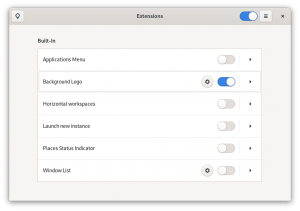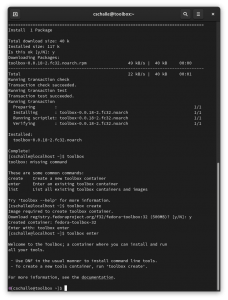As Fedora Workstation 32 was released today I ended up looking back at our efforts to drain the swamp over the last 6 years. In April of 2014 I wrote a blog post outlining our vision for the Fedora Workstation effort and what we wanted to achieve with it. I hadn’t looked at that blog post in years, but it was interesting going back to it and realize that while some of the details have changed it is still the vision we are pursuing today; to keep draining the swamp and make Fedora Workstation a top notch operating system for developers and makers in general. Which I guess is one of the hallmarks of a decent vision, that it allows for the details to change without invalidating it.
One of my pet peeves at the time with Linux as a desktop operating system was that so many of the so called efforts to make linux user friendly was essentially duck taping over the problems, creating fragile solutions that often made it harder for us to really move forward. In the yers since we addressed a lot of major swamp issues with our efforts around HiDPI & Bolt (getting ahead of hardware enablement for new monitors and Thunderbolt devices respectively), Flatpaks, GNOME Software and AppStream (making applications discoverable, deployable and maintainable), Wayland (making your desktop secure and future proof), LVFS and firmware handling (making them easily available for Linux users), Finger print reader standard (ensuring your hardware is fully supported) and coming up with ways to improve the lives of developers with improvements to the terminal or Fedora Toolbox, our developer pet container tool.
Working on these and other issues we early realized that a model where hardware gets enabled in a reactive manner, in response to new laptops being sold, was never going to yield a good result for our users. As long as we followed that model people where bound to always hit issues with laptops as they came out and then have to deal with those issues for the first 6-12 Months of its life. This is why I am so excited about our new partnership with Lenovo that we pre-announced on Friday as it is both the culmination of our efforts over the last 6 years, but also the starting point of a new era in terms of how we work with hardware makers. So instead of us spending a ton of time trying to reverse engineers basic drivers we can now rely on our hardware partner and their component vendors providing that and we can instead focus on what I call high level hardware enablement. Meaning that as we see new features coming into laptops and computers we can try to improve the infrastructure in the operating system to be able to take full advantage of said hardware, and we can do so in collaboration with the hardware makers knowing that once we provide the infrastructure they will ensure to provide drivers and similar fitting into that infrastructure. Our work on fingerprint readers and thunderbolt support for instance has been two great early examples of that.
Anyway, you are probably interested to know some of the new things coming in Fedora Workstaton 32, so here are some of my personal highlights:
New lock screen
This is more a cosmetic change, but one that every user will see upon logging into their Fedora system after a new install or upgrade. The new design features a faded version of your desktop background image and it should also feel more smooth as the password dialog now appears on the lock screen page as opposed to before where it sort of replaced it. The dialog now also tries to more discreetly than before inform you if your trying to type in the password while the lock screen is on. A big thanks to Allan Day and the GNOME design team for their work here trying to polish this part of the user interface.
GNOME extension app
GNOME Shell extensions are little tweaks and additional features for the desktop that our user have gotten accustomed to and enjoy greatly. Extensions are also the technology that powers the GNOME Classic session that provides those of our users who want it with a more traditional desktop experience. GNOME Shell extensions have gradually evolved in how we work with them since their inception as something you install through your web browser to now being handled through GNOME Software. With Fedora Workstation 32 we are making the new GNOME Shell extensions management app available as the next step in the evolution of GNOME Shell extensions, making it simple to turn any given extension on of our or quickly see which extensions you have installed.

GNOME Extensions handling app
Fedora Toolbox
Fedora Toolbox is our helper for making working with containers for development and testing as easy it possibly can be. Debarshi Ray and Ond?ej Míchal have been hard at work porting the Fedora Toolbox to Go from shell for this release. For those wondering why we choose Go as the language; there was basically two reasons for that. One we felt that the toolbox had gone as far as it could as a shell script, and two that was the language used by all the components we rely on and interact with in the container space, like buildah and podman. We also wanted to make it easy for developers on those projects to contribute by using the same language as they use in their projects.

Fedora Toolbox running on Fedora Workstation 32
Performance improvements
Another area that we always try to give some love is general performance improvement. For example this time around Christian Hergert identified some really bad behavior of GNOME shell when running on a system with very high I/O. At the face of it GNOME Shell didn’t look like it should have been affected, but during some intensive debugging sessions Christian Hergert discovered that I/O was triggered by various API calls to do things like string translation. So he put together a set of patches to resolve the high I/O stalls and can now report that GNOME Shell keeps running smoothly as silk, even under high disk I/O situations.
PipeWire
Wim Taymans keeps making great strides forward with PipeWire, our tool for creating a unified media handler for audio, pro-audio and Video. In Fedora Workstation 32 we will be shipping the 0.3 version which has quite complete Jack support. In fact we are hoping to team up with the Fedora Jam team to finalize the Jack support during the Fedora 32 lifecycle by testing it extensively. We have a lot of Jacks apps already working with PipeWire, including a series of important Jack apps that we have put into Flatpaks in Fedora like Carla. While the support is there in PipeWire in Fedora 32 right now, there are some convenience work we are still needing to do, but we hope to get that pushed out by next week to make replacing Jack with PipeWire becomes very simple to both do and undo for testing purposes.
The PulseAudio support is the last piece that are still in progress. It works for simple music playback, but it is not a drop in replacement for PulseAudio yet, so while we hoped to encourage widespread testing in F32 we will aim at delaying that to F33 in order to polish the PulseAudio support more first. But once ready we will make this available for testing in a simple manner just like the Jack support.
There has also been further work on the video side of PipeWire, adding support for zero copy video capture, this has reduced the overhead of doing things like screen capturing significantly and should be a nice performance/resource usage improvement for everyone.
Firefox on Wayland
Martin Stransky and Jan Horak has been working hard to improve how Firefox runs and works when used as a Wayland native application fixing a truckload of bigger and smaller bugs this cycle. We feel that we crossed the corner now in terms of the Wayland version being just as stable and good as the X11 one. In fact we could move beyond just fixing bugs to actually adding features this time around for instance Martin Stransky worked on WebGL HW acceleration support enabling us to have that enabled by default now for the first time. We also made sure to taking advantage of the Pipewire zero copy support to improve your video conferencing applications running under Firefox which turned out to be even more important than we expected considering Covid-19 has everyone working from home.
Looking forward
We spent a lot of time and energy over the last 6 years to get to where we are now, putting in place a lot of the basic building blocks needed to make Linux a great desktop operating system. And it feels great that just as we kick of the new line of Lenovo laptops running Fedora we are also entering a new phase of development where we can move beyond getting our basic infrastructure in place, but we can really start taking advantage of it to rapidly improve the experience we are providing even more. A good example is the Firefox work mentioned above, where we finally could move on from ‘make it work with Wayland and PipeWire, to ‘lets take advantage of these new pieces to make Firefox on Linux better’. Another example here is that Adam Jackson is currently investigating how we can improve how Fedora Workstation performs for remote usage. This work includes looking at things like VNC and RDP and commercial offerings and figuring out how we can make our stack work better with such tools, on top of the improvements that PipeWire brings for such usecases.
There is some more heavy lifting needed before our next generation OS architecture, Silverblue, is ready to be our default offering, but it is improving leaps and bounds each release and already have a loyal following, personally I am very excited about the fact that we are quickly moving closer the point were we can make it our default and through that offer features like bulletproof OS updates, factory resets and solid version rollbacks.
On the Flatpak side Owen Taylor and Alex Larsson are putting in a lot of final touches on our Red Hat infrastructure. So for RHEL8.2 we will finally be able to build Flatpaks in RHEL infrastructure and provide a runtime and SDK for our RHEL customers to use. But equally exciting is that we will be able to offer these to the community at large, meaning that we can offer a high quality Flatpak Long Term Support runtime and SDK for ISVs that they can use to both target RHEL users, but also Fedora and other Linux distributions with, in a similar vein to how the Red Hat UBI works. We will also be looking at ways to make getting access to these on Fedora very simple for developers, so that developing towards this runtime becomes quick and easy on your Fedora system. Alex and Owen are also working on an incremental updates feature to be shared between Kubernetes containers and OCI Flatpaks, making both technologies better and updates a lot smaller.
We are also looking at a host of other smaller improvements, many of them in collaboration with our friends at Lenovo, like lap detection (so you can be sure the laptop doesn’t burn you), privacy features (like making it harder to read your screen from an angle) and far field microphones. There are also things like Lennarts HomeD idea which we will be looking at as a way to improve the end user experience.
So the future is looking bright and I hope to see many new faces in the Fedora community going forward, be that if you download Fedora Workstation 32 to install on your own system yourself or if you join us through buying a Fedora laptop from Lenovo this summer.

